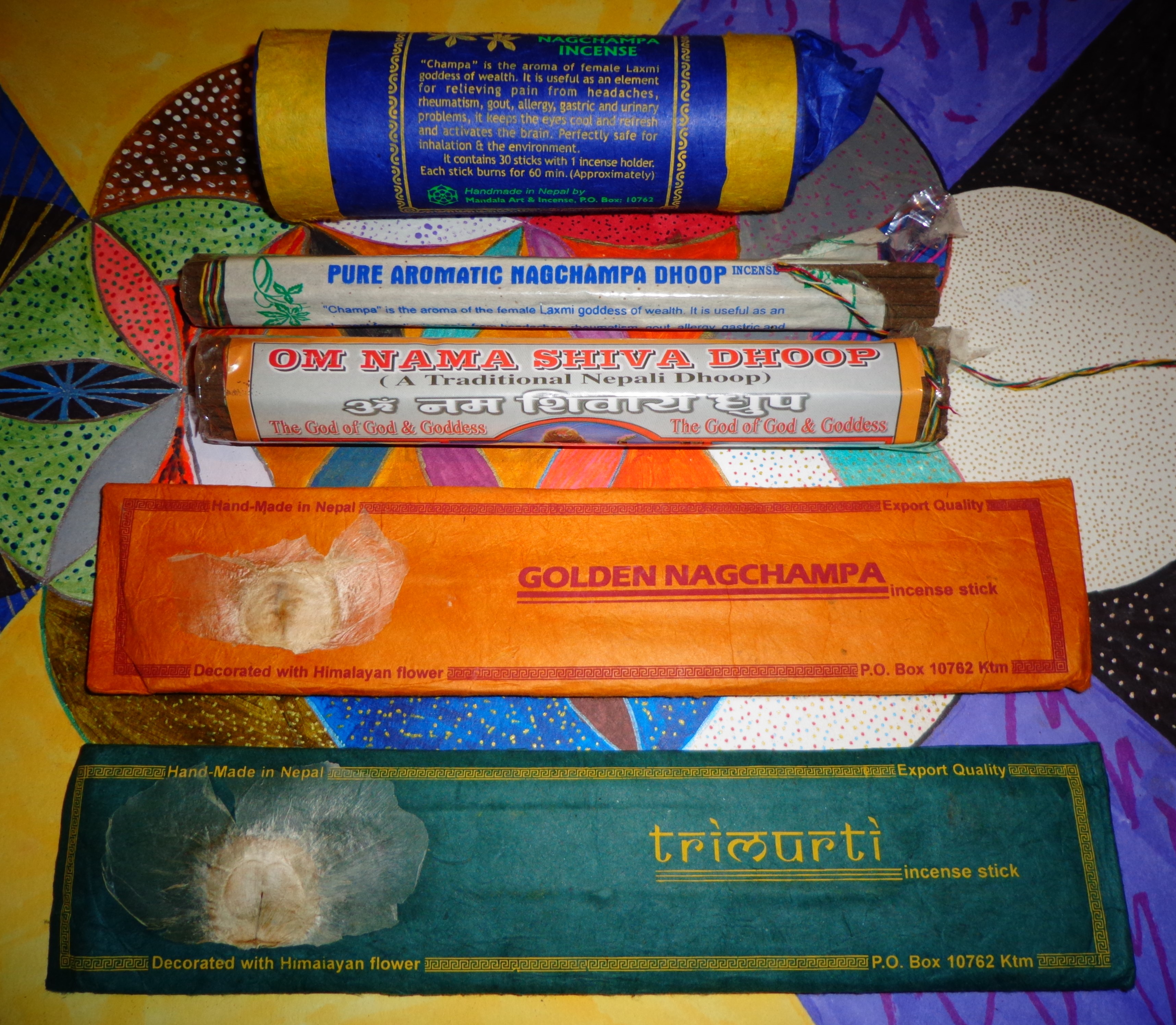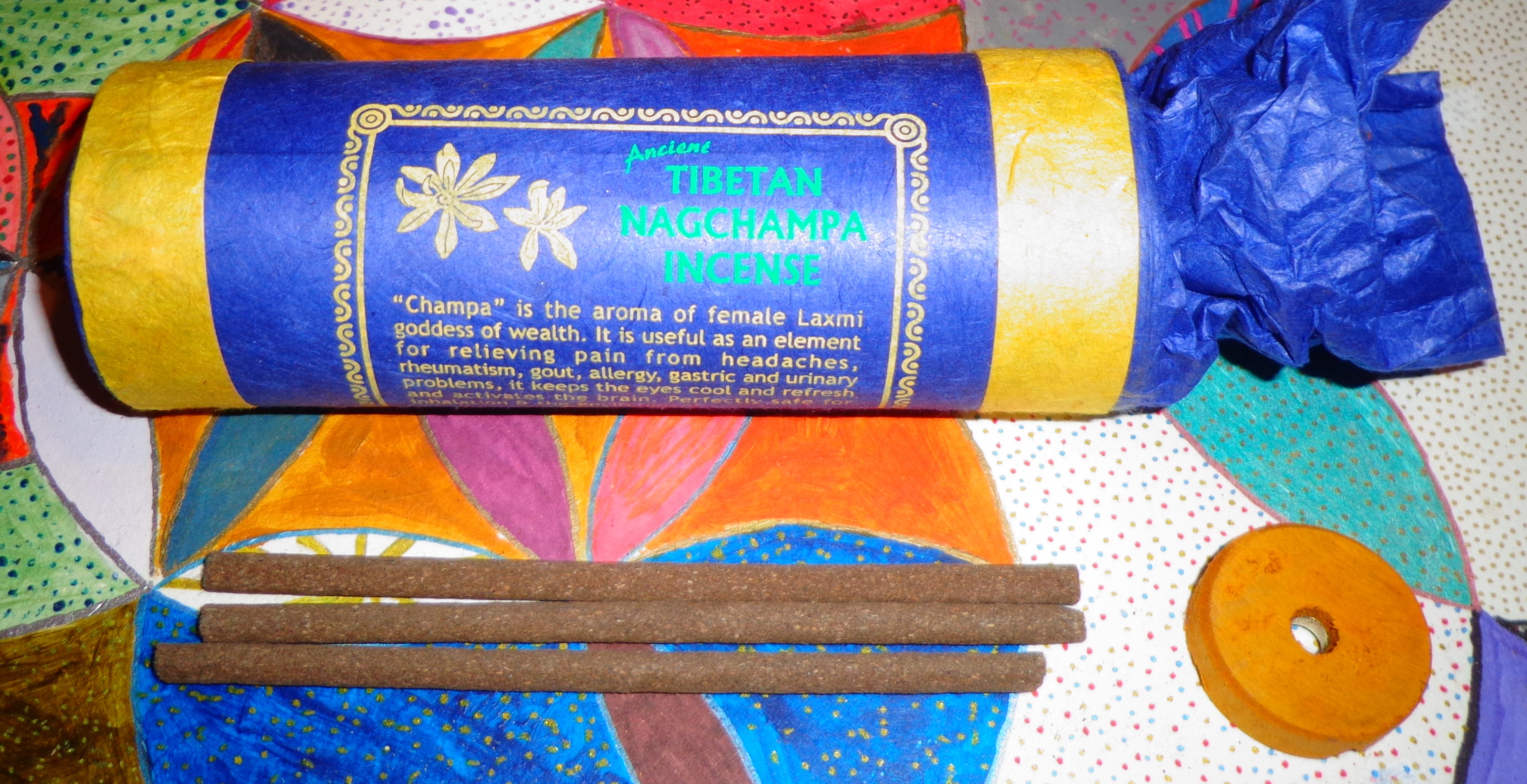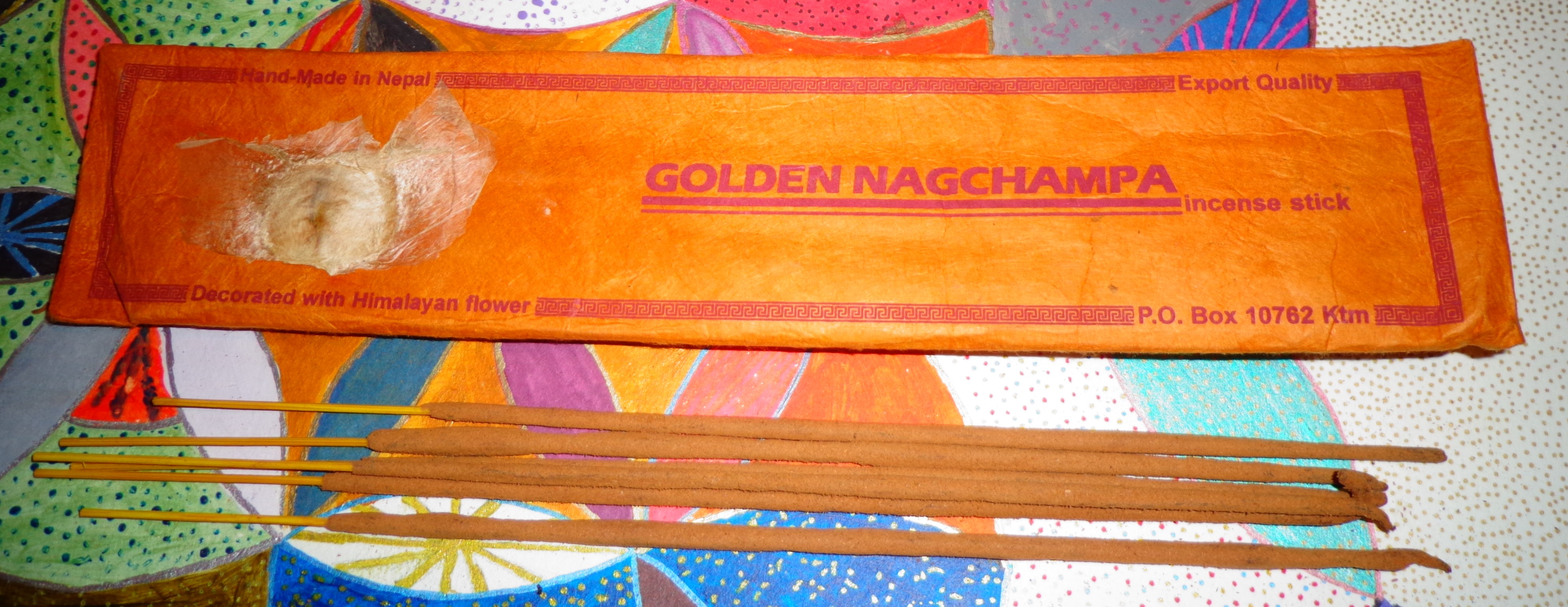 In addition to the Meena and other Indian incenses Everest Traders sent over, they also sent over a quintet of Nepali incenses. Since Essence of the Ages left the incense business, there has been a big hole where a solid source used to be for these incenses, as incensetraditions.ca carries primarily Tibetan and Bhutanese incenses only. Hither and Yon seems to be the primary source for Nepali incenses these days (note as always that “Tibetan” is also used as a style in the sense it means incense that does not use bamboo sticks through the middle, a distinction I need to make for later in this writeup) and there are a few others, but we’re always interested in hearing about new sources.
In addition to the Meena and other Indian incenses Everest Traders sent over, they also sent over a quintet of Nepali incenses. Since Essence of the Ages left the incense business, there has been a big hole where a solid source used to be for these incenses, as incensetraditions.ca carries primarily Tibetan and Bhutanese incenses only. Hither and Yon seems to be the primary source for Nepali incenses these days (note as always that “Tibetan” is also used as a style in the sense it means incense that does not use bamboo sticks through the middle, a distinction I need to make for later in this writeup) and there are a few others, but we’re always interested in hearing about new sources.
 And it was interesting in looking around a bit that the first incense that pops up at Hither and Yon is Mandala Art & Incense’s Tibetan Nagchampa, because Everest Traders is carrying it at a little over half the price. You have to go back to 2009 the last time I reviewed incenses by this long standing company and I don’t believe any of them were these tubes of 5″ incenses. But that brings me to one distinction I have to make. Nagchampa incenses, of course, are still some of the most popular incenses you can buy, but the Tibetan style versions of these are very different. Indian nagchampas, at least at their best, were only part the perfume from the aroma – part of their success was the marriage this scent had with a halmaddi-rich masala base, a combination often missing even from Indian versions these days. And so what you get from a Tibetan version like this one is the powdery and accessible floral scent on the base of a Nepali-Tibetan style. I have tried some Tibetan nagchampas I couldn’t wait to dump the package of, this version almost feels like it could be a standard to compare others to. Like a lot of Nepali bases there is a feeling that some inexpensive woods are used to ground the incense, but it at least gets over the hump of not having a bitter or conflicting base to it and the top note is certainly pleasant. Amazingly at times it even has something like a Japanese woodiness to it which is quite intriguing. And at this price it’s certainly well worth checking out to get an idea of what one of these is like.
And it was interesting in looking around a bit that the first incense that pops up at Hither and Yon is Mandala Art & Incense’s Tibetan Nagchampa, because Everest Traders is carrying it at a little over half the price. You have to go back to 2009 the last time I reviewed incenses by this long standing company and I don’t believe any of them were these tubes of 5″ incenses. But that brings me to one distinction I have to make. Nagchampa incenses, of course, are still some of the most popular incenses you can buy, but the Tibetan style versions of these are very different. Indian nagchampas, at least at their best, were only part the perfume from the aroma – part of their success was the marriage this scent had with a halmaddi-rich masala base, a combination often missing even from Indian versions these days. And so what you get from a Tibetan version like this one is the powdery and accessible floral scent on the base of a Nepali-Tibetan style. I have tried some Tibetan nagchampas I couldn’t wait to dump the package of, this version almost feels like it could be a standard to compare others to. Like a lot of Nepali bases there is a feeling that some inexpensive woods are used to ground the incense, but it at least gets over the hump of not having a bitter or conflicting base to it and the top note is certainly pleasant. Amazingly at times it even has something like a Japanese woodiness to it which is quite intriguing. And at this price it’s certainly well worth checking out to get an idea of what one of these is like.
 So how does the Natural Nepali Dhoop Pure Aromatic Nagchampa Dhoop compare? This Natural Nepali Dhoop incense is part of a large line that are mostly formatted as “Pure Aromatic Something Dhoop” and tend to be carried by shops that import Nepalis. Back in 2011 I was extremely nonplussed by the four incenses I tried in the line, or at least I think it was the same line, because I don’t remember the packages claiming what company they were from (which obviously could have changed in all this time). My issue with poorer Nepali incenses in general, when they show up, is that the bases use very cheap filler woods, I would guess poor quality juniper or pine, and at their harshest these impart bitter and campfire like notes that basically sabotage whatever it is the creators are trying to do with them. And I mention this as context as the incenses I reviewed back then were very much like this, but part of the issue was the oils used were also not pleasant. Fortunately the oil on the Nagchampa isn’t harsh but it also doesn’t have quite the resolution of the MA&I version and while the base isn’t too bad there are still some notes in the mix that are a bit distracting. It’s also perhaps a touch less sweeter. But it does have some interesting floral notes and the base is certainly more workable than what I would have expected. I’d certainly start with the MA&I version as ultimately they are close enough in style where you’d only need one or the other and I would expect this latter version to end up fatiguing.
So how does the Natural Nepali Dhoop Pure Aromatic Nagchampa Dhoop compare? This Natural Nepali Dhoop incense is part of a large line that are mostly formatted as “Pure Aromatic Something Dhoop” and tend to be carried by shops that import Nepalis. Back in 2011 I was extremely nonplussed by the four incenses I tried in the line, or at least I think it was the same line, because I don’t remember the packages claiming what company they were from (which obviously could have changed in all this time). My issue with poorer Nepali incenses in general, when they show up, is that the bases use very cheap filler woods, I would guess poor quality juniper or pine, and at their harshest these impart bitter and campfire like notes that basically sabotage whatever it is the creators are trying to do with them. And I mention this as context as the incenses I reviewed back then were very much like this, but part of the issue was the oils used were also not pleasant. Fortunately the oil on the Nagchampa isn’t harsh but it also doesn’t have quite the resolution of the MA&I version and while the base isn’t too bad there are still some notes in the mix that are a bit distracting. It’s also perhaps a touch less sweeter. But it does have some interesting floral notes and the base is certainly more workable than what I would have expected. I’d certainly start with the MA&I version as ultimately they are close enough in style where you’d only need one or the other and I would expect this latter version to end up fatiguing.
 So in order to properly review Traditional Nepali Dhoop Pvt. Ltd.’s Om Nama Shiva Dhoop (I could not find an ebay link to this at present, but will add when I’m made aware of it) I thought it worth queueing up the great Steve Hillage. Of the incenses in this review this is probably the most traditionally Tibetan of the five. It reminded me that outside of the great Dhoop Factory and a restock of Yog Sadhana it had been years since I tried a Nepali incense like this and it’s a bit of a shift from the Tibetan incenses from the autonomous region. The difference I think is largely in the base still and we’re given natural essential oils, flowers, spices, aromatic herbs, natural resins and other aromatic substances as ingredients, so basically the whole kitchen and then some. And like many of these incenses all of these things are blended as a whole and difficult to pick out separately, although I find this blend to be an interesting almost peppery meets tangy herbal mix on top of the woody base. The issue with many Nepali imports is whether they rise to level of something distinctive like so many of the autonomous region incenses do. So I would have to say that while this is distinctly aromatic and pleasant, it may not quite reach that level, but after a few sticks I’ve started to notice the resin peeping out a bit amongst all the herbal qualities so it may very well be a grower.
So in order to properly review Traditional Nepali Dhoop Pvt. Ltd.’s Om Nama Shiva Dhoop (I could not find an ebay link to this at present, but will add when I’m made aware of it) I thought it worth queueing up the great Steve Hillage. Of the incenses in this review this is probably the most traditionally Tibetan of the five. It reminded me that outside of the great Dhoop Factory and a restock of Yog Sadhana it had been years since I tried a Nepali incense like this and it’s a bit of a shift from the Tibetan incenses from the autonomous region. The difference I think is largely in the base still and we’re given natural essential oils, flowers, spices, aromatic herbs, natural resins and other aromatic substances as ingredients, so basically the whole kitchen and then some. And like many of these incenses all of these things are blended as a whole and difficult to pick out separately, although I find this blend to be an interesting almost peppery meets tangy herbal mix on top of the woody base. The issue with many Nepali imports is whether they rise to level of something distinctive like so many of the autonomous region incenses do. So I would have to say that while this is distinctly aromatic and pleasant, it may not quite reach that level, but after a few sticks I’ve started to notice the resin peeping out a bit amongst all the herbal qualities so it may very well be a grower.
 Moving to the Golden Nagchampa and Trimurti, we’re also moving from the Tibetan style to the bamboo stick centered Indian masala style. Both of these two incenses are from a gigantic line as well, although I’ve never known what company produces them from the wrappers themselves and never got around to reviewing any back in the day. Like the Pure Aromatic Dhoop, my experiences were not always positive in the past, nor have they been recent enough to remember all that well, but perhaps with these two we have a good example of what works and perhaps doesn’t. Golden nagchampas just by name usually imply a flora or fluxo style, in fact back when halmaddi was more prevalent, a golden nagchampa was likely to be a Sai Flora like incense in some fashion. That’s true here as well although mostly because the perfume has that similarity in the front, the stick here is generally not thick enough to be a true flora style. It’s mostly a dusted charcoal but it feels soft enough to perhaps have a little halmaddi in the mix and sure enough it’s overall a sweet and pleasant scent. And perhaps in the middle there’s a little bit of woodiness or base that will remind you it’s not an Indian stick, as I can’t really think of another Indian scent I’ve tried recently that fits this general area. It’s also quite a bit drier a burn than say so many of the vedic incenses I have been sampling lately that it also makes a nice contrast. One of the better Nepali-Indian hybrids I’ve tried.
Moving to the Golden Nagchampa and Trimurti, we’re also moving from the Tibetan style to the bamboo stick centered Indian masala style. Both of these two incenses are from a gigantic line as well, although I’ve never known what company produces them from the wrappers themselves and never got around to reviewing any back in the day. Like the Pure Aromatic Dhoop, my experiences were not always positive in the past, nor have they been recent enough to remember all that well, but perhaps with these two we have a good example of what works and perhaps doesn’t. Golden nagchampas just by name usually imply a flora or fluxo style, in fact back when halmaddi was more prevalent, a golden nagchampa was likely to be a Sai Flora like incense in some fashion. That’s true here as well although mostly because the perfume has that similarity in the front, the stick here is generally not thick enough to be a true flora style. It’s mostly a dusted charcoal but it feels soft enough to perhaps have a little halmaddi in the mix and sure enough it’s overall a sweet and pleasant scent. And perhaps in the middle there’s a little bit of woodiness or base that will remind you it’s not an Indian stick, as I can’t really think of another Indian scent I’ve tried recently that fits this general area. It’s also quite a bit drier a burn than say so many of the vedic incenses I have been sampling lately that it also makes a nice contrast. One of the better Nepali-Indian hybrids I’ve tried.
 The issue with Trimurti and this is one ORS staff discuss a lot is that when incenses are named after religious or spiritual concepts, gods and goddesses etc, it can be tough to get a bead on what’s actually going on in the scent and so I’m limited in my description to say how successful the Trimurti is for what it’s trying to accomplish. From my perspective Trimurti barely gets past its base which is some sort of nebulous mix of evergreen woods. It’s also a bit spicy and I would guess there might be a bit of something like myrrh or gugal gum in the mix. What is perhaps missing and I can compare this to the Golden Nagchampa (which has it) is an intensity in aroma that makes it a bit more memorable and attention arresting. I do seem to remember the line was full of incenses like this. It may be entirely because the line is using 100% natural ingredients and not any sort of perfume wizardry, which would largely be in keeping with many Nepali incenses. But keep in mind as well if this is something you might recognize as an aroma you like you could feel differently from me.
The issue with Trimurti and this is one ORS staff discuss a lot is that when incenses are named after religious or spiritual concepts, gods and goddesses etc, it can be tough to get a bead on what’s actually going on in the scent and so I’m limited in my description to say how successful the Trimurti is for what it’s trying to accomplish. From my perspective Trimurti barely gets past its base which is some sort of nebulous mix of evergreen woods. It’s also a bit spicy and I would guess there might be a bit of something like myrrh or gugal gum in the mix. What is perhaps missing and I can compare this to the Golden Nagchampa (which has it) is an intensity in aroma that makes it a bit more memorable and attention arresting. I do seem to remember the line was full of incenses like this. It may be entirely because the line is using 100% natural ingredients and not any sort of perfume wizardry, which would largely be in keeping with many Nepali incenses. But keep in mind as well if this is something you might recognize as an aroma you like you could feel differently from me.
You must be logged in to post a comment.